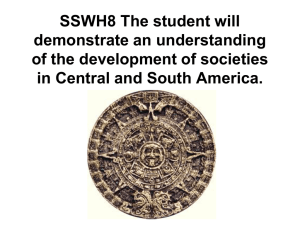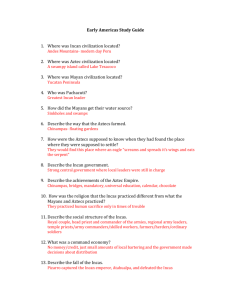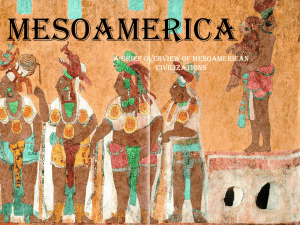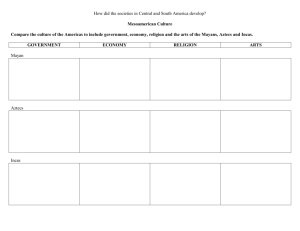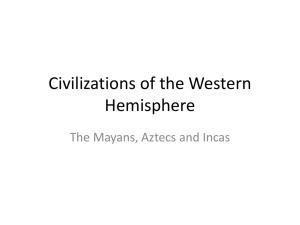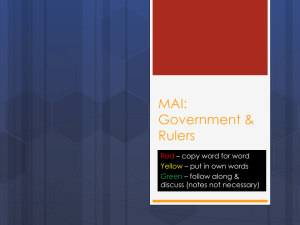Trimester II Final Study Guide Mayans, Aztecs, and
advertisement
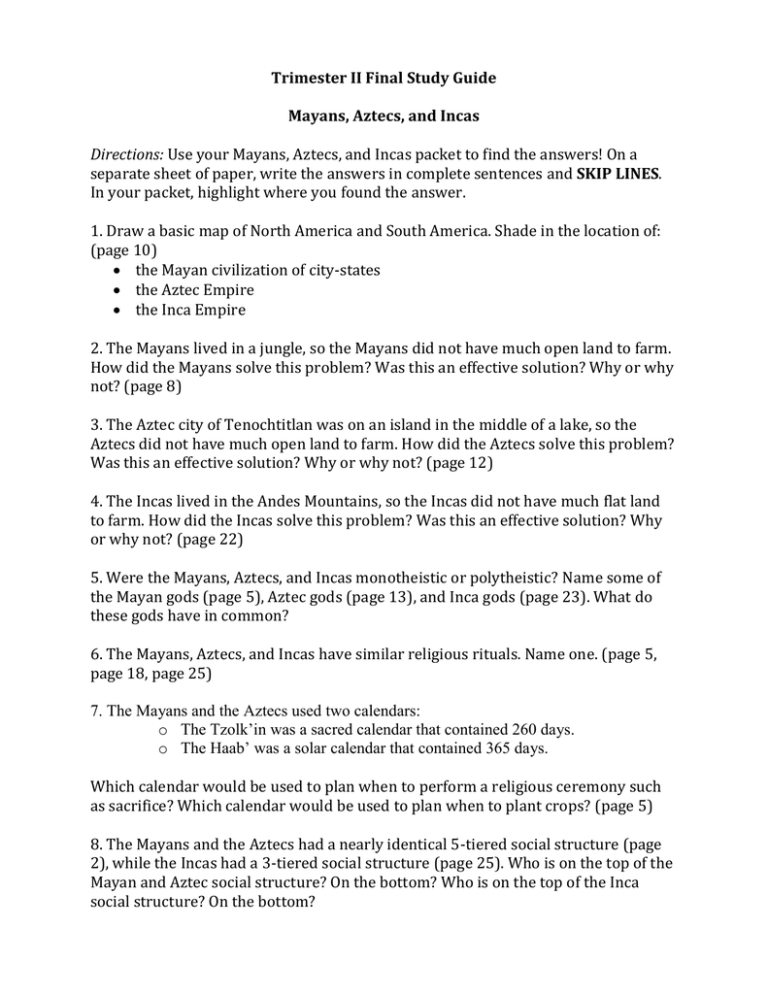
Trimester II Final Study Guide Mayans, Aztecs, and Incas Directions: Use your Mayans, Aztecs, and Incas packet to find the answers! On a separate sheet of paper, write the answers in complete sentences and SKIP LINES. In your packet, highlight where you found the answer. 1. Draw a basic map of North America and South America. Shade in the location of: (page 10) the Mayan civilization of city-states the Aztec Empire the Inca Empire 2. The Mayans lived in a jungle, so the Mayans did not have much open land to farm. How did the Mayans solve this problem? Was this an effective solution? Why or why not? (page 8) 3. The Aztec city of Tenochtitlan was on an island in the middle of a lake, so the Aztecs did not have much open land to farm. How did the Aztecs solve this problem? Was this an effective solution? Why or why not? (page 12) 4. The Incas lived in the Andes Mountains, so the Incas did not have much flat land to farm. How did the Incas solve this problem? Was this an effective solution? Why or why not? (page 22) 5. Were the Mayans, Aztecs, and Incas monotheistic or polytheistic? Name some of the Mayan gods (page 5), Aztec gods (page 13), and Inca gods (page 23). What do these gods have in common? 6. The Mayans, Aztecs, and Incas have similar religious rituals. Name one. (page 5, page 18, page 25) 7. The Mayans and the Aztecs used two calendars: o The Tzolk’in was a sacred calendar that contained 260 days. o The Haab’ was a solar calendar that contained 365 days. Which calendar would be used to plan when to perform a religious ceremony such as sacrifice? Which calendar would be used to plan when to plant crops? (page 5) 8. The Mayans and the Aztecs had a nearly identical 5-tiered social structure (page 2), while the Incas had a 3-tiered social structure (page 25). Who is on the top of the Mayan and Aztec social structure? On the bottom? Who is on the top of the Inca social structure? On the bottom? 9. Describe the legend that explains how the Aztec Empire began. (page 11) 10. Describe the legend that explains how the Inca Empire began. (page 23) 11. Mayan civilization can best be described as a collection of independent citystates (Tikal, Palenque, Chichen Itza, etc.), each ruled by a king (page 4-5, page 9). Aztec civilization each best be described as an empire, ruled by one emperor who lives in a capital city (Tenochtitlan) (page 15). Inca civilization can best be described as an empire, ruled by one emperor who lives in a capital city (Cuzco) (page 28). Draw a simple diagram of Mayan civilization. Draw a simple diagram of Aztec civilization. Draw a simple diagram of Inca civilization. 12. How did Aztec Empire gain its wealth? Would you want to be from the city-state of Xochonochco? Why or why not? (page 17) 13. Why did the Spanish conquistadors want to conquer the Aztecs and the Incas? List 3. (mostly page 33, but also 31-32 and 34-35) 14. What advantages did the Spanish conquistadors have over the Aztecs and the Incas? List 5. Which advantage led to the death of most Aztecs and Incas? (mostly page 31-32, but also 33-35) 15. Who built the building(s) in each image? In which city can you find the building(s) in each image? (page 3, page 13, page 24) Image A Image B Image C 16. Which civilization did not have a system of writing? What did this civilization use instead of writing? (page 26) Imperial China Directions: Use your China packet to find the answers! On a separate sheet of paper, write the answers in complete sentences and SKIP LINES. In your packet, highlight where you found the answer. 17. Emperor Qin unified China. What does it mean to unify? (Hint: a unicorn has one horn, a unicycle has one wheel, there is only one universe, etc.) (page 5) 18. Emperor Qin standardized Chinese culture, including the writing, money, and laws. What does standardize mean? (page 5) 19. Why did Emperor Qin build the Great Wall of China? (page 5) 20. Emperor Qin was a Legalist. How did he treat the Confucian scholars who disagreed with him? (page 6) 21. Why did Emperor Qin order people to build him a terra-cotta army? (page 6) 22. Emperor Qin and Emperor Han both ruled with the help a bureaucracy. Emperor Qin had an aristocracy, while Han had a meritocracy. What is the difference between an aristocracy and a meritocracy? (page 8-9) 23. China once was isolated from other cultures because of geographical barriers such as mountains to the west, deserts to the north, and an ocean to the east. However, China eventually learned about other cultures. Why was China able to learn about other cultures? (page 10) 24. Did the Silk Road help or hurt the Roman Empire? Why? (page 11) 25. During the Han Dynasty, which religion traveled along the Silk Road from India to China? (page 10, 12-13) 26. During the Tang Dynasty, which religious group was persecuted, and why? (page 14-15) 27. Which Mongol leader conquered China? During his rule of China, was the Silk Road safer or more dangerous to travel? (page 16-17) 28. During the Qin Dynasty, Emperor Qin chose the richest to work for the government. During the Han Dynasty, the emperors chose the smartest to work for the government. During the Yuan Dynasty, who did the emperors choose to work for the government? (page 16-17) 29. Where was Marco Polo from, and what was his job? How did his book The Travels of Marco Polo change the relationship between China and Europe? (page 1617) 30. Why did Zheng He go on seven naval voyages? (page 20-21) 31. At the end of the Ming Dynasty, the Chinese emperor decided that China’s foreign policy would be isolationism. What does this mean? (Hint: isolate = to make something separate or alone) Give three examples of isolationism. (page 21) 32. Historians sometimes talk about the Four Great Inventions of China. These inventions are: compass, gunpowder, papermaking, and printing. (page 23, 24, 26) Fill in the blanks below with these inventions. When the Chinese had a copper coin shortage, they used ___________________________ and _____________________________ to make paper money. When the Mongolians invaded Japan, they used ________________________ to frighten the Japanese horses. When Zheng He went on a naval voyage, he needed a ________________________ to help navigate the ocean. 33. Name a Chinese farming strategy and a Chinese farming tool that led to a surplus of food. (page 28) 34. In order to increase commercial activity, how did the Chinese improve water transportation? How did the Chinese increase the money suppgly? (page 29)
